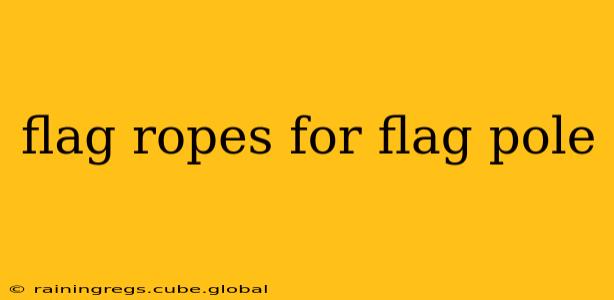Choosing the right flag rope for your flagpole is crucial for ensuring the safety and longevity of your flag. A poorly chosen rope can lead to damage to the flag, the flagpole, or even injury. This comprehensive guide will walk you through everything you need to know about selecting the ideal flag rope, covering different types, materials, and considerations for various flagpole sizes and types.
What Types of Rope are Used for Flagpoles?
Several types of rope are suitable for hoisting flags, each with its own advantages and disadvantages. The most common include:
-
Nylon Rope: This is a popular choice due to its strength, durability, and resistance to UV degradation. Nylon ropes are relatively lightweight, making them easy to handle, and they're resistant to stretching and shrinking. This makes them a good all-around option for most flagpoles.
-
Polyester Rope: Similar to nylon, polyester offers excellent strength and durability. It's often chosen for its resistance to rot and mildew, making it ideal for outdoor use in humid or wet climates. Polyester ropes can also be slightly more abrasion-resistant than nylon.
-
Polypropylene Rope: A more budget-friendly option, polypropylene ropes are lightweight and float. However, they are generally less durable than nylon or polyester and can be more susceptible to UV degradation and breakage over time. They are best suited for smaller flags or less demanding applications.
What is the Best Rope for a Flagpole?
The "best" rope depends on several factors, including:
-
Flagpole Height: Taller flagpoles require stronger, thicker rope to withstand the weight and wind load.
-
Flag Size and Weight: Larger and heavier flags will require a more robust rope to prevent breakage.
-
Climate: In harsh climates with extreme temperatures or high humidity, a rope with excellent UV and moisture resistance is essential.
Generally, nylon or polyester ropes are recommended for most flagpoles, offering a balance of strength, durability, and ease of use. Polypropylene can be considered for smaller flags and poles in milder climates, but it should not be used for large flags or tall poles in windy locations.
How Long Should My Flag Rope Be?
The length of the rope depends largely on your flagpole's height and the type of pulley system you're using. You'll want enough rope to easily raise and lower the flag, with some extra to accommodate for potential slack or wear over time. It's advisable to have at least twice the length of the flagpole as a starting point. Consider measuring from the ground to the top of the flagpole and then doubling it. Many flagpole retailers offer pre-cut rope specifically designed for various flagpole heights, simplifying the selection process.
How Do I Replace Flag Rope?
Replacing your flag rope is a relatively straightforward process, but it's essential to follow safety precautions. Always ensure the flagpole is secure and stable before attempting any maintenance. Consult the instructions for your specific flagpole for detailed steps. Generally, this involves:
- Lowering the flag: Carefully lower the flag to the ground.
- Untie the halyard: Untie the old rope from the halyard (the rope that attaches to the flag).
- Remove the old rope: Carefully remove the old rope from the flagpole's pulley system.
- Install the new rope: Thread the new rope through the pulley system, ensuring it's properly secured.
- Attach the halyard: Re-attach the halyard to the new rope.
- Raise the flag: Raise the flag to its proper position.
What Size Rope Do I Need for My Flagpole?
The necessary rope diameter will depend heavily on the size and weight of the flag and the height of the flagpole. Larger flags and taller poles require thicker ropes to support the additional weight and potential wind resistance. Consult your flagpole manufacturer’s specifications or a reputable retailer for guidance on appropriate rope size. As a general guideline, thicker rope is always preferable for added strength and durability.
Can I Use Other Types of Cordage for Flagpoles?
While rope is the most common and suitable material for flagpoles, other cordage such as twine or paracord are generally not recommended. These materials lack the strength and durability needed to withstand the stresses of raising and lowering a flag, particularly in windy conditions. Using inappropriate cordage could lead to flag damage or even accidents.
By carefully considering the factors outlined above, you can ensure you select the appropriate flag rope for your flagpole, preserving the integrity of your flag and protecting your investment. Remember, proper rope selection is vital for safe and reliable flag display.
